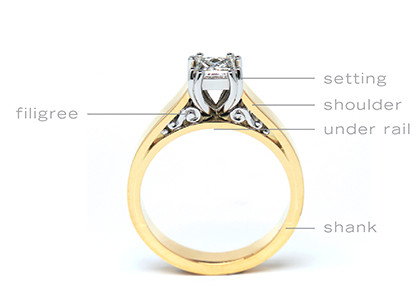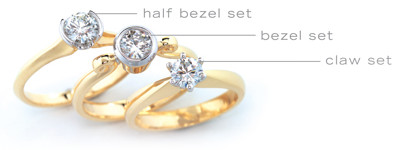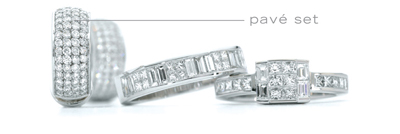design terms
the basic structure of jewellery
In your search for the perfect piece of jewellery, you might notice a certain design feature catches your eye. But what's it called?
Becoming familiar with the basic structure of jewellery can help you find those particular elements that appeal to you, ultimately leading you to the design of your dreams.
Elements of a ring

THE SETTING
The setting of a ring or other piece of jewellery is the part that holds the stone (more detail below).
THE SHOULDERS
The shoulders are the pieces of metal that go from the shank to the setting. These can be many shapes and sizes. They can be very simple or can be enhanced by being set with stones.
THE SHANK
The shank is the rail or band on a ring that surrounds the finger.
FILIGREE or INLAYS
Filigree or inlays are intricate, decorative sections used to enhance the design. Often they are put between the shoulders and the under-rail and in this position they also serve to add strength to the piece.

Types of settings
HALF BEZEL or PART BEZEL
is a setting that has wide pieces of gold that hold the stone in place. These can be made with plain or fancy sides and can be used to hold stones of all shapes.
BEZEL or FULL BEZEL
is a setting that has gold wrapped around the whole stone to hold it in place.They can be made with plain or fancy sides and can be used to hold stones of all shapes.
CLAWS or PRONGS
These are pieces of wire that hold a stone in place. They come in many shapes and thicknesses. Claw settings can consist of two claws, right up to more than eight claws for larger stones. This type of setting can be used to hold stones of all shapes.

GRAIN SETTING
This is where the stones are set into the gold by raising small beads of gold over the edge of the stone. This type of setting can be used to enhance shoulders and other flat parts of metal and is used to set small stones.
CHANNEL SETTING
is the method of setting a row of stones between two pieces of metal like a railway track. This setting will incorporate small stones cut in the following styles: round, princess, emerald and baguette. The stones can be all the same size or taper from large to small.

PAVE
is the technique of setting many small stones together in groups or rows. Small beads of gold are used to hold each stone. This type of setting is used to set only very small stones.

PUNCH SET
This setting involves stones being set into the gold with the metal pushed around them. This setting is used to set stones in random order in wide pieces of metal and is most often used to set small stones.




The information below is required for social login
Sign In
Create New Account